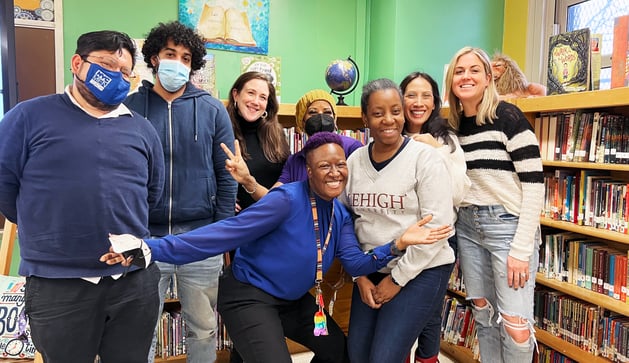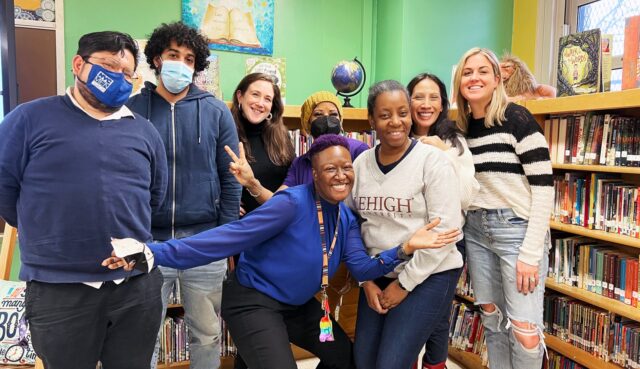What does it look like to create a sense of belonging in elementary math classrooms? That is the question Emma Ershow and Carolyn DiProspero, senior educational consultants at Teaching Matters, sought to answer in a six-month project funded by a grant from the national STEM organization, Beyond100K.
Research shows that inclusive learning environments foster a sense of belonging – the perception that one is valued and respected in a given context – for all students. Further, the field has defined mathematics identity as “one’s sense of belonging to the mathematics community, a sense of achievement based on the norms of the mathematics community, and specific behaviors that are associated with members of the mathematics community” (Boaler et al., 2000 in Miller-Cotto & Lewis, 2020 in Mindset Scholars Network, 2020).
Emma and Carolyn partnered with a team of educators and administrators at PS X126 in the Bronx in a series of sessions designed to unpack teachers’ own identities as mathematicians and build understanding around how math identities are formed in “foundational” or elementary classrooms. Their work culminated in a co-designed unit unpacking protocol informed by Dr. Gholdy Muhammad’s Five Pursuits and intended to center student identities in the teacher planning process.
For educators looking to incorporate student identity in their math classrooms, let’s take a look at the project and key actions that teachers can take to make their math instruction reflective of the students in their classrooms.
Educators Examine Their Own Math Identities
The early sessions of the project focused on creating space for administrators and teachers to reflect on their own math stories – the early experiences and messages received from influential figures in their lives that contributed to their math “autobiography.” Teachers also reflected on the math vision they have for their classroom or what they would like students to say about math, themselves as mathematicians, and their teacher as a math role model. These initial sessions focused on self-reflection were key for teachers to examine their own internal narratives around mathematics, to reflect on the power they have as math role models for their students and to bring awareness to any biases they might carry into the classroom.
Uncovering the Student Perspective
The middle sessions of the project focused on collecting student perception data from students at PS 126 and then using this data to inform teacher planning. Students were asked to complete a survey that covered everything from how they view math and themselves as mathematicians to the role of making mistakes and their preferences around learning math. Teachers analyzed this survey data in combination with a study of Dr. Gholdy Muhammad’s Five Pursuits to identify key educator and student mindsets when approaching math instruction. The educators then applied these new understandings to create relevant and rigorous math tasks.
Enacting a Protocol
Finally, teachers put it all together by co-designing a unit-unpacking protocol informed by the Five Pursuits and teachers’ understanding of student identities. The protocol is intended to support teachers who follow a set curriculum in building community, creating connection to student interests and lived experiences and differentiating for a variety of learners within their mathematics classrooms.
Watch the video below to see the teachers using the protocol to plan a second grade unit on place value. Note how the teachers are considering identity and joy when planning for upcoming instruction. Click here to see their final unit plan and follow along.
After participating in this project, teachers shared reflections on the impact of the work on their teaching practices.
Watch this video to hear Ms. Garcia and Ms. Harm of PS 126 share more about their experience.
This has been an amazing experience that will allow me to take these tools and reach the students who are not engaged and engage them so that they love education, love themselves, and love math.
Rocio Garcia
This was wonderful. I can relate to the struggles students have and I am very excited to be able to try and change the way we go about teaching math. I think it is so important for students to have an environment where they feel supported, comfortable, and confident.
Anonymous quote from survey
Takeaways
We’d like to share a few action steps educators can take to try this in their own school communities:
- Provide reflection time for educators to examine their own math identities and autobiographies. How did you see yourself as a mathematician in elementary school? How do you view your relationship with math now? Where did these perceptions come from?
- Allow opportunities for students to share their perspective through surveys or interviews. Possible questions include: What words or emojis best describe how you feel about math? Why? How often do you use math outside of school? Who is a mathematician? Who makes mistakes in math?
- Engage teachers in a professional learning cycle including a study of the text Cultivating Genius by Dr. Gholdy Muhammad, followed by an analysis of relevant curricula using the Five Pursuits as a common framework.
